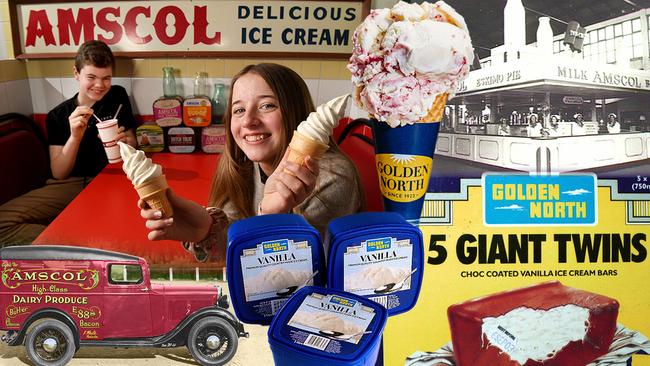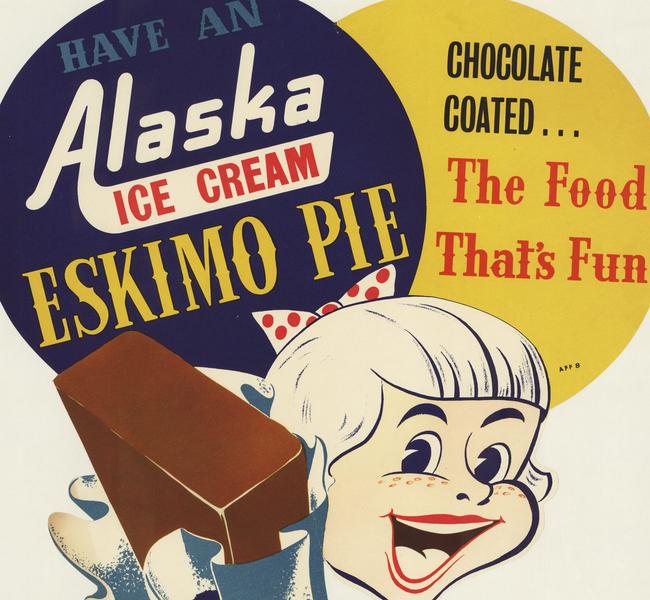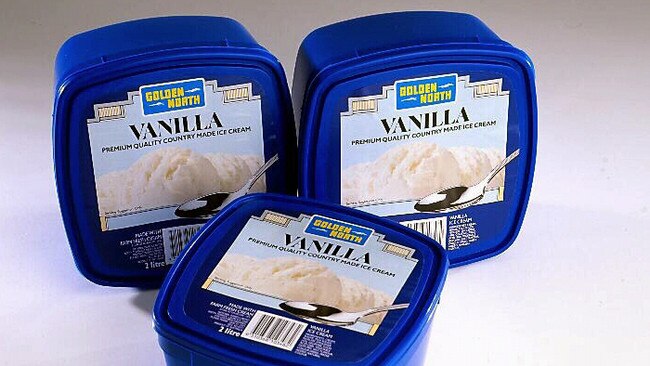SA’s most iconic ice cream brands – and the stories behind them
These days, huge corporations have the ice cream market licked. But some of SA’s best-loved brands live on – at least in our memories.

Lifestyle
Don't miss out on the headlines from Lifestyle. Followed categories will be added to My News.
It’s funny to think about now, but 100 years ago, commercially-made ice cream was still a novelty in Australia, with local producers looking to manufacturers overseas for the technology and know-how to build an industry at home.
Once manufactured ice became steadily available from the mid-1800s, dozens of ice cream companies started popping up all over the country.
Always ahead of the curve, many pioneers in the industry were here in SA.
As we head into ice cream season, we take a look back at South Australia’s most iconic ice cream brands and the stories behind them.
ALASKA ICE CREAM

Starting life as the Adelaide Crystal Ice Company in 1879, the company began making ‘Alaska ice cream’ in 1915, and in 1920, Alaska Ice Cream Co Ltd became a separate company.
In 1923, the company acquired the SA rights to manufacture the Eskimo Pie, an ice cream bar, covered in chocolate, patented in the US in 1922 by Christian Kent Nelson and his business partner Russell Stover.
News reports show Alaska had factories in both Thebarton and Broken Hill in the early 1920s and in 1929 joined forces with Peters to become Peter’s Alaska Ice Cream Company.
An article in the News in 1930 described the company as “a pioneer of the ice cream trade in South Australia” and told readers about a recent upgrade to both factories.
“The work was done under the direction of Mr A. C. Perrins, who is factory and production manage for the company,” the News reported.
“Mr Perrins has had wide experience in the dairying and ice cream industry. He is a graduate of the Elsenburg College of Agriculture of South Africa and of the La Salle University of Chicago, United States of America.
“Perrins spent 10 years in Canada, which holds the world championship for ice cream, and before coming to South Australia obtained six gold and five silver prizes during 1924 to 1928.
“His services have been retained by Peters Alaska Icecream Company, thus assuming the public of a supply of ice cream of excellent quality”.
Peters changed hands several times during the 80s and 90s and is now owned by European food giant Froneri.
In 2020, Peters announced it would be renaming the Eskimo Pie to Polar Pie, acknowledging the term ‘Eskimo’ was racially offensive.
“Peters Ice Cream is committed to being a part of the solution on racial equality and we acknowledge that now is the time for change,” a spokesperson for Peters said in a statement.
SNOWDROP ICE CREAM
One of the earliest ice cream brands in SA, Snowdrop was manufactured by A Williams in Rosa St Goodwood, with newspaper records showing it was in business as early as 1911.
As a 1915 article in The Mail on the ice cream industry in SA explained, Williams hailed from Liverpool and trained with the British Navy before getting a job as chief cook on Australian coastal ships.
On a visit to Sydney, Williams saw a large soda fountain in a shop window and thought it would be “an excellent investment” to put one on a trolley so he could take the business to the streets.
Williams often took his trolley to the “Adelaide Market” where his soda fountain became a “popular institution”.
“However, the cry of the children was ‘Give us ice cream!”, the Mail reported.
In 1911, Williams bought a one-horsepower engine and a five-gallon churn and set up shop in Rosa St. After selling out his stock, Williams expanded his plant and started advertising, which triggered a slew of inquiries from shopkeepers keen to start stocking his ice cream.
“Williams’s ice cream had really become famous in a night,” the Mail reported adding that Williams had outlaid a whopping 4000 pounds to establish his state-of-the art operation.
“Besides the engines there are numerous churns, freezers, boilers, icebreakers, and everything necessary to produce a superior ice cream, one that catches the public taste”.
“The demand is so great that none is forwarded to the country. The theatres are all supplied and the camp authorities welcome this brand,” the paper reported.
“William’s Snowdrop ice cream is distinguished for its smoothness, consistency, lightness, and
delightful flavour, and the manufacturer claims his article is the finest producer on the market.
“Its undoubted and widespread popularity is proof positive of the truth of his contentions.”
AMSCOL

Best known by its acronym (AMSCOL), the Adelaide Milk Supply Cooperative Limited, was founded in Carrington St in January 1922.
The company was set up as a milk co-op of more than 500 milk producers to purchase Beauchamp Bros, the largest milk retail business in Adelaide at the time.
In 1923 the business bought more land and expanded to nearby Bewes St, and in 1924 started making the ice cream products that would establish it as an SA icon.
AMSCOL also made and supplied bottled milk, cream, butter and cheese, with cheese factories at Mount Torrens and Victor Harbor.
As former Advertiser columnist and founder of the Adelaide Remember When Facebook page Bob Byrne wrote, the company started making ice cream bricks in the 1950s as household refrigerators started hitting the appliance market.

Enjoying a slice of AMSCOL ice cream after dinner became a treasured family ritual, helped along by the company’s famous advertising slogan “It’s a food, not a fad!”
“Even as I’m writing this, I’m immediately transported back in time to being a kid again, and Friday nights, when sometimes as a special treat we had takeaway fish and chips, and then dad would carefully slice the brick of ice cream into six equal proportions served with mum’s preserved peaches from our own peach tree,” Bryne wrote in 2014.
“It’s not hard to understand why we still have such a soft spot for AMSCOL; it was the ice cream we grew up with and people today still swear it was creamier and had a far better flavour than anything currently on the market.”

As Byrne writes, the company moved away from bricks in the 1960s and started selling ice cream in distinctive decorative tins, with flavours including Dutch treat chocolate, wild strawberry, rainbow, honeycomb fudge, lime crinkle and vanilla.
Other iconic products included dandies (known elsewhere as dixie cups) and berry bars and a range of ice creams in the colours of the various SANFL teams.
It also sold tins of ice cream with cards featuring photos of SANFL players stuck under the lid – now rare collectibles among footy fans.
AMSCOL was sold in the 1980s to ice cream giant Streets, which shut down operations in SA in 1987, putting 34 people out of work and bringing its 65-year history of manufacturing in the state to a close.

In 2019, nearly 40 years after the AMSCOL brand was retired, SA businessman Stewart Kay, announced plans to revive the iconic range of dairy products at the retro diner Cherry Burger at Colonnades Shopping Centre after buying the rights to the brand around 2012.
Mr Kay, who previously worked for Wendy’s and Farmer’s Union, said he had been working with the diner’s owners to recreate AMSCOL’s iconic range as faithfully as possible.
“(The recipe is) a fairly simple specification – we have taste-tested and have a flavour profile and company feel,” Kay says. “It’s a privilege to bring it back.”
But sadly the comeback was short-lived. The diner closed in 2021 and, to date, AMSCOL hasn’t announced any plans to bring its products back to market in SA.
FREESIA


Made by Peter Smyth & Sons of Murray Bridge, this iconic SA ice cream brand was born in the early 1930s.
According to Smyth’s grandson, also Peter, the name Freesia was chosen because Mr Smyth had a friend who worked in a local florist.
“Grandpa Smyth was in his shop one day and said, ‘We’re going to make more ice cream, and I’m looking for a name for it’, and apparently his mate was working on a freesia and said, ‘What about Freesia?’”, he told the Murray Bridge News.
P. Smyth & Sons was founded in 1923 and started life as a milk cooling and ice factory before branching out into ice cream.

Flavours included vanilla, neapolitan and chocolate ripple and the Freesia brand became widely known by its colourful containers.
According to the Murray Bridge & District Historical Society Facebook page, when refrigerators suddenly made it possible for families to store ice cream at home, Mr Smyth engaged an Adelaide company to make a 2.25L tin “believed to be the first bulk ice cream for home consumption”.
The company moved to Adelaide in 1982, the Murray Bridge News reported.
The Freesia brand was eventually retired in the 1980s after the business was acquired.
It remained just a memory for over 40 years until June 2023, when artisan Adelaide ice-cream maker Gelista announced it was bringing the brand, and its distinctive packaging, back.
Gelista founder Peter Cox told the Murray Bridge News he wanted to revive an iconic brand that for many South Australians of a certain age would inspire a wave of nostalgia.
“Eating ice cream is quite a nostalgic thing to do, and we wanted to bring back that joy and happiness and that idea of sitting down as a family and sharing Freesia,” Mr Cox said.
Freesia is now available at selected stockists across SA.
GOLDEN NORTH

This iconic SA brand was founded by William Bowker and family, who started selling milk and cream from their dairy in Laura in 1880 before venturing into the ice cream business in 1923.
The Golden North factory still operates from the same site.
According to the official history, Golden North was the first manufacturer to produce a half gallon (2L) container of ice cream, introducing the product in 1940.
Golden North makes a range of different ice creams, but is especially beloved for its iconic Giant Twins ice cream bar.
The singular product got the name “twins” because it used to be handmade in trays with an indentation, which imprinted on to the ice creams when frozen.

As The Advertiser reported in 2017, a bit of clever marketing turned those indentations into a handy way to snap the bars in half to share.
Production of the bars is now automated, so the trays and the little indentations are gone.
But as Golden North operations manager Rick Willis said at the time, the chocolatey ice cream treats are just too good to share.
“As our diets have evolved and we get a bit greedier … we like to eat a bit more than we used to, so instead of sharing, we tend to eat it all ourselves.”
The Bowker family sold the company to Farmers Union in 1983, it was sold again to a group of four SA businessmen in 2001 and finally to a group comprising five SA families in 2008.
The company celebrated its first shipment of products to China in 2015 and was inducted into the SA Food Hall of Fame in 2016.
This year marks the company’s 100th anniversary.
IMPERIAL/EXCELSIOR ICE CREAM

Imperial Ice Cream was founded in 1916 by Italian immigrant Felice Maggi and was based in St Vincent St Port Adelaide.
A 1919 SA trade directory includes a listing for Maggi as an ice cream maker based in Alberton.
According to Desmond Connor in his 1996 book, No Need to be Afraid: Italian Settlers in South Australia Between 1839 and the Second World War, Maggi sold his business after being called up to serve in World War I.
According to Connor, Maggi was an “ardent propagandist” for the local community of fascists in Adelaide, but that’s a whole other story! You can read more here.
After returning from the war, Maggi opened a new ice creamery, this time on South Terrace, on the current site of Pulteney Grammar school, trading first as Excelsior Ice Cream and Ice Works and later the Blue Label Ice Cream Company.
In 1929, the a fire broke out in the factory, threatening the Gilles Street State School at the rear and causing 10,000 pounds worth of damage, the Register News reported.
Mr Maggi, who lived next door, “made a desperate effort to save the motor lorries garaged at the rear of the building, but five of them were partially destroyed”.





